Volleyball drills for technique passing / defense / reception
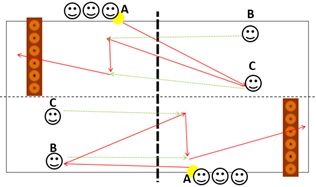
- Player A throws ball over the net.
- Player B or C passes the ball over the net.
- The other player quickly runs under the net and sets up the ball for the same player who passed.
- This player tries to get a pawn off the bench with overhand play or a hitting move.
Which pair or team has knocked the most pawns off the bench after X number of minutes?
everyone a ball
- play the ball underarm independently. (2 minutes)
- Play from your legs, no arm waving.
- keep your arms stretched
- Make sure the ball falls on your wrists.
- Push your hands downwards.
2. pass the ball underarm in pairs (8 minutes)
- play under the net (force your knees to go up)
- 3 meter from each other (1 side of the net)
- 6 meter from each other (1 side of the net)
- play the ball over the net to each other underarms
Warming up / all-round training
Each player will pass, attack, distribute, block, defend, rally, with turnovers.
#2 means
- Trainer stands with cart with balls at the pole at #2 (position 2)
- Players stand outside the field at the side of #1 and a playmaker at # 2/3
- First round starts with Trainer throwing the ball to #5, player 1 runs from the sideline to the ball and plays it to the distributor.
- Start with "blue players" (see drawing), then extend with "red players
Further course of play:
- Tr throws ball for S1 to #5
- S1 runs in and plays to Sv (#2/3)
- Sv gives setup to the outside (#4)
- S1 attacks.
- Turn over: S1 becomes Sv, Sv gets the ball and joins the line at #1.
Expansion 1
- Sv turns to the other side of the net and becomes a blocker.
Now the same steps as above, but with the block opposite the attacker. - Turn over: S1 (has just attacked) becomes Sv at #2/3, Sv
passes under the net and becomes B1 at #2B1
who, after blocking, goes to get the ball and joins the row.
Extend 2
- After blocking at #2, player goes to defend at #5. Attacker is obliged to pass to #5.
- When the ball is defended a rally may be played (2 vs. 2)
- After end of rally or no defence or fault in attack, turn over
Extend 3 and more
- One can extend with a 2nd blocker, 2nd and 3rd defender (on resp. #1 and #6)
- More players can be added to field I (so players from the sideline move in when a rally arises)
- The passing game becomes S1 (passing and attacking) -> Sv -> B1 (#3) -> B2 (#2) -> V1 (#1) -> V2 (#6) -> V3 (#5) possibly A2 (#4) and then connect again.
- You can expand to 6 against 6, so start with blue, then B1, then B2, then V1, then V2 (when continuing the game, first V2 and then V1), then V3 (continuing the game with V2, V3, V1) and then possibly A1. In the meantime, players in field I must be added.
- If there are several players in Area I, you can choose to throw in a ball on S1 at #5 instead of throwing in a ball through Tr.
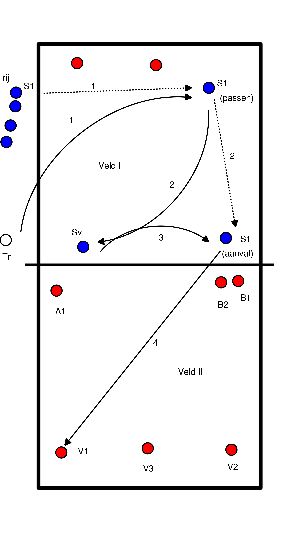
- In today's top basketball we can see that the two-handed pass from above the head is frequently used.
- It is therefore important that we stimulate the players to use this pass in certain situations.
Pay attention in the exercises:
- Pass must come high so player can catch the ball 'overhand'.
- Pass to the right, right foot forward
- Pass to the left, left foot forward
- Eyes" of the shoulders in the direction of play
The exercise:
- 3 pairs with 1 ball.
- 1 and 2 stand next to each other, not too close to the net.
- 3 faces 1 in the back of the court.
- 1 throws straight at 3 and 3 passes diagonally to 2.
- 2 catches and throws straight on to 3 and 3 passes diagonally to 1.
- So 3 moves around all the time.
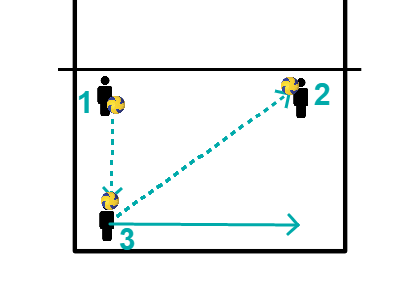
- 4 players are in the line-up. 1 of the players SV.
- 3 other players serve.
- Perfect pass to SV
- SV plays behind 3 meter line for attack.
- 10 balls change.
- team is in line.
- serve on team
- team builds attack, completes it.
- Coach plays next ball immediately,
- 4x in quick succession.
- 4 teams of which 2 at the net and the other 2 at the back of the field
- B throws the ball to A
- A plays the ball back to B
- B plays ball UPHANDS to C
- C plays the ball UNDER HANDS to D
- D catches the ball
- D throws the ball to C
- C plays the ball UP to B
- B plays the ball UNDER HANDS to A
- A catches the ball
- etc
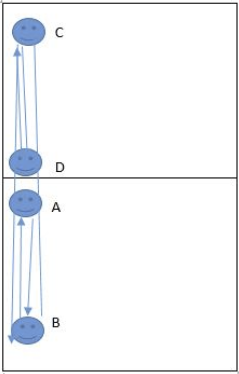
- Ball toss in pairs
- hitting back with one arm.
- Start with your good arm.
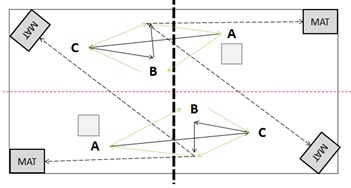
- Player A throws/strikes the ball towards player C.
- Player C serves the ball to player B.
- Player B gives a pass to c.
- Player C passes to the mats.
Goal: try to attack/play 3rd ball on the mats (straight or diagonal).
After each ball move one place in your own group.
Extension: When there are enough players one could also choose to place a block.
pair
- the players stand behind each other, the player in front hits the ball hard,
- the other player takes off from behind player 1
- and tries to send the ball back to player 1 bra or oh.
- Please note that the player must turn before she plays the ball back.
Goal of the exercise:
Ball carrier must learn to act quickly after set-up and find new ball
Explanation of the exercise:
- Playmaker exercise.
- Five on one side of the net.
- On the other side, you could also have 5.
- Front left and front right both have a ball.
- Playmaker stands in the middle.
- The left back and right back bring the pass.
- The first ball is thrown by the left back towards the left back.
- At the moment the left back touches the ball, the right back throws the ball to the right back.
- If you have more players, you can choose to change the one who passed with the one who is on hold.
- In this way, the passes reach the defender immediately after each other.
- The pass from the left back is played by the distributor to the left front.
- Immediately after the set-up, do not follow the ball but look for the other pass from the right back and set-up the set-up for the right front.
- Many ball contacts for the playmaker.







